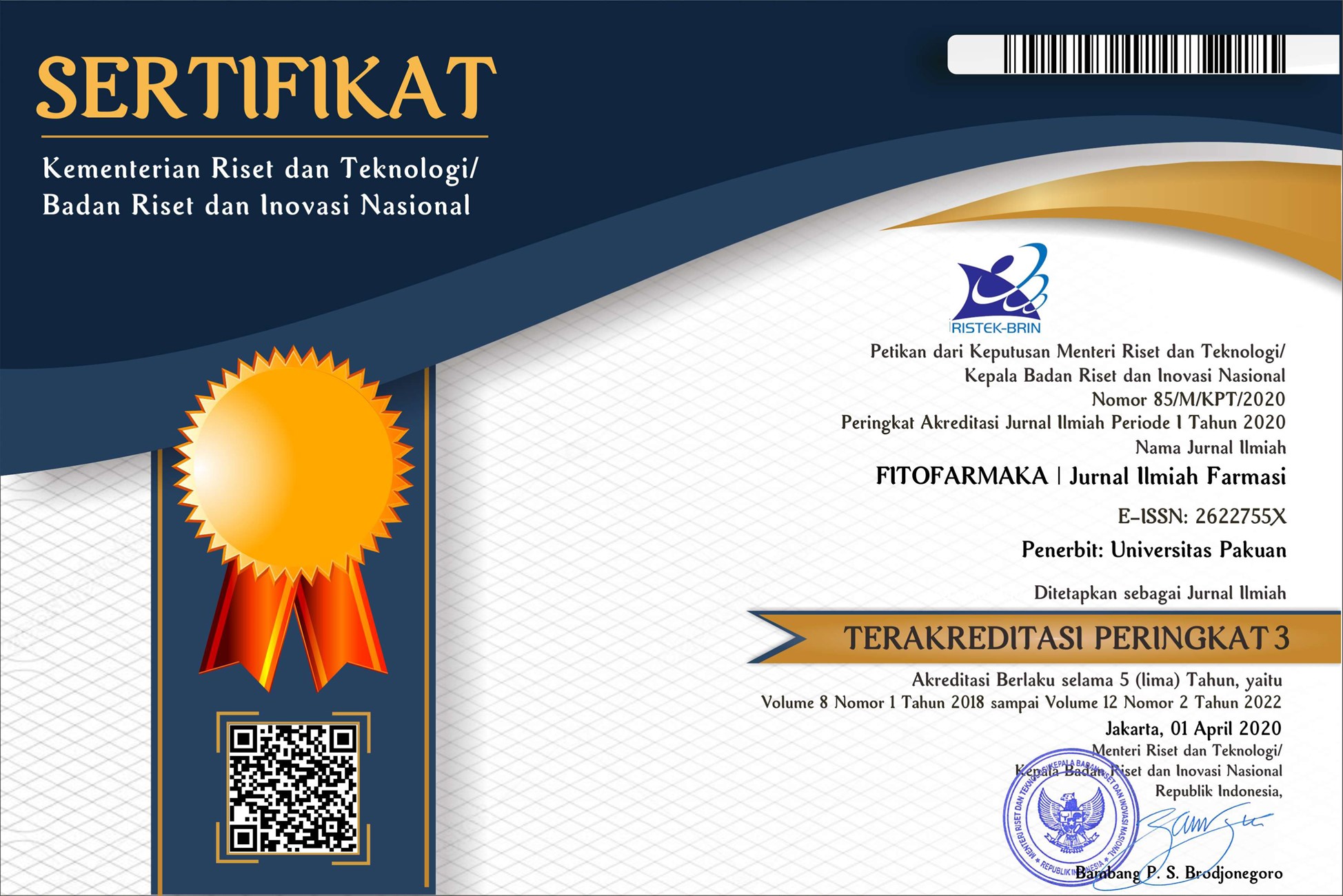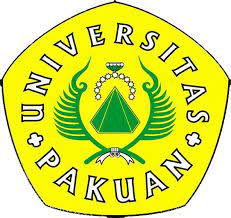STUDI PENAMBATAN MOLEKUL DAN PREDIKSI ADMET SENYAWA METABOLIT SEKUNDER TANAMAN KELOR (Moringa oleifera L.) SEBAGAI INHIBITOR BACE1 PADA PENYAKIT ALZHEIMER
Abstract
Alzheimer merupakan penyakit neurodegeneratif yang ditandai dengan adanya deposisi amiloid, kusut neurofibrillary, disfungsi sinaptik, dan kematian sel saraf. Patofisiologi utama dari neurodegeneratif yaitu adanya produksi yang berlebihan atau akumulasi β-amiloid (Aβ), yang memiliki beberapa efek merusak pada aktivitas sinaptik. Aβ dihasilkan dari protein prekursor amiloid (APP) melalui pembelahan proteolitik oleh enzim pembelahan APP situs-1 (BACE1). Terapi farmakologi untuk alzheimer pada saat ini hanya berfungsi untuk mengurangi gejalanya saja dan tidak berpengaruh pada perkembangan penyakit alzheimer. Moringa oleifera L. atau kelor memiliki efek nootropik dan dapat meningkatkan memori serta melindungi dari neurodegenerasi. Hasil penelitian menunjukkan bahwa niazirin yang terdapat pada tanaman kelor memiliki interaksi terbaik dengan reseptor BACE1 yang ditunjukkan dengan nilai energi ikatan (∆G) sebesar -4,13 kkal/mol yang memiliki ikatan hidrogen pada gugus alkoksi dengan asam amino ARG68 dan ASN175 serta interaksi hidrofobik pada gugus benzena dengan LEU228. Niazirin memiliki profil farmakokinetik yang baik dan dapat menembus sawar darah otak yang sesuai dengan desain obat alzheimer.
Keywords
References
Bachurin, S. O., Bovina, E. V., & Ustyugov, A. A. (2017). Drugs in Clinical Trials for Alzheimers Disease: The Major Trends. Medicinal Research Reviews, 37, 11861225. https://doi.org/https://doi.org/10.1002/med.21434
Balamurugan, V., & Balakrishnan, V. (2013). Preliminary Phytochemical, Pharmacognostic Evaluation and Antimicrobial Activity of Moringa Concanensis Nimmo Leaf 1,2*. 2(2), 243247.
Coimbra, J. R. M., Marques, D. F. F., Baptista, S. J., Pereira, C. M. F., Moreira, P. I., Dinis, T. C. P., Santos, A. E., & Salvador, J. A. R. (2018). Highlights in BACE1 Inhibitors for Alzheimers Disease Treatment. Frontiers in Chemistry, 6, 178. https://doi.org/10.3389/fchem.2018.00178
Cumming, J. N., Smith, E. M., Wang, L., Misiaszek, J., Durkin, J., Pan, J., Iserloh, U., Wu, Y., Zhu, Z., Strickland, C., Voigt, J., Chen, X., Kennedy, M. E., Kuvelkar, R., Hyde, L. A., Cox, K., Favreau, L., Czarniecki, M. F., Greenlee, W. J., Stamford, A. W. (2012). Structure based design of iminohydantoin BACE1 inhibitors: Identification of an orally available, centrally active BACE1 inhibitor. Bioorganic and Medicinal Chemistry Letters, 22(7), 24442449. https://doi.org/10.1016/j.bmcl.2012.02.013
Das, B., & Yan, R. (2017). Role of BACE1 in Alzheimers synaptic function. Translational Neurodegeneration, 6(1), 411. https://doi.org/10.1186/s40035-017-0093-5
Ekins, S., Mestres, J., & Testa, B. (2007). In silico pharmacology for drug discovery: applications to targets and beyond. British Journal of Pharmacology, 152(1), 2137. https://doi.org/https://doi.org/10.1038/sj.bjp.0707306
El-Alfy, T. S., Ezzat, S. M., Hegazy, A. K., Amer, A. M. M., & Kamel, G. M. (2011). Isolation of biologically active constituents from Moringa peregrina (Forssk.) Fiori. (family: Moringaceae) growing in Egypt. Pharmacognosy Magazine, 7(26), 109115. https://doi.org/10.4103/0973-1296.80667
Kumar Bargah, R., & Das, C. (2014). Isolation and Characterization of Steroidal Glycoside from Chloroform Extract of the Stem Bark of Moringa Pterygosperma Gaertn. International Journal of Innovative Research in Science, Engineering and Technology (An ISO, 3(12), 1831918322. https://doi.org/10.15680/IJIRSET.2014.0312077
Leone, A., Spada, A., Battezzati, A., Schiraldi, A., Aristil, J., & Bertoli, S. (2015). Cultivation, genetic, ethnopharmacology, phytochemistry and pharmacology of Moringa oleifera leaves: An overview. International Journal of Molecular Sciences, 16(6), 1279112835. https://doi.org/10.3390/ijms160612791
Lipinski, C. A. (2004). Lead- and drug-like compounds: The rule-of-five revolution. Drug Discovery Today: Technologies, 1(4), 337341. https://doi.org/10.1016/j.ddtec.2004.11.007
Mahaman, Y. A. R., Huang, F., Wu, M., Wang, Y., Wei, Z., Bao, J., Salissou, M. T. M., Ke, D., Wang, Q., Liu, R., Wang, J.-Z., Zhang, B., Chen, D., & Wang, X. (2018). Moringa Oleifera Alleviates Homocysteine-Induced Alzheimers Disease-Like Pathology and Cognitive Impairments. Journal of Alzheimers Disease, 63, 11411159. https://doi.org/10.3233/JAD-180091
Mortelmans, K., & Zeiger, E. (2000). The Ames Salmonella/microsome mutagenicity assay. Mutation Research/Fundamental and Molecular Mechanisms of Mutagenesis, 455(1), 2960. https://doi.org/https://doi.org/10.1016/S0027-5107(00)00064-6
Musfiroh, I., Muchtaridi, M., Muhtadi, A., Diantini, A., Hasanah, A. N., Udin, L. Z., Susilawati, Y., Mustarichie, R., Kartasasmita, R. E., & Ibrahim, S. (2013). Cytotoxicity studies of xanthorrhizol and its mechanism using molecular docking simulation and pharmacophore modelling. Journal of Applied Pharmaceutical Science, 3(6), 715. https://doi.org/10.7324/JAPS.2013.3602
Premi, M., & Sharma, H. K. (2017). Effect of extraction conditions on the bioactive compounds from Moringa oleifera (PKM 1) seeds and their identification using LCMS. Journal of Food Measurement and Characterization, 11(1), 213225. https://doi.org/10.1007/s11694-016-9388-y
Ramachandran, B., Kesavan, S., & Rajkumar, T. (2016). Molecular Modeling and Docking of Small Molecule Inhibitors Against NEK2. Bioinformation. Biomedical Informatics, 12(2), 6268.
Rani, N. Z. A., Husain, K., & Kumolosasi, E. (2018). Moringa genus: A review of phytochemistry and pharmacology. Frontiers in Pharmacology, 9(FEB), 126. https://doi.org/10.3389/fphar.2018.00108
Sahakitpichan, P., Mahidol, C., Disadee, W., Ruchirawat, S., & Kanchanapoom, T. (2011). Unusual glycosides of pyrrole alkaloid and 4′-hydroxyphenylethanamide from leaves of Moringa oleifera. Phytochemistry, 72(8), 791795. https://doi.org/10.1016/j.phytochem.2011.02.021
Sashidhara, K. V., Rosaiah, J. N., Tyagi, E., Shukla, R., Raghubir, R., & Rajendran, S. M. (2009). Rare dipeptide and urea derivatives from roots of Moringa oleifera as potential anti-inflammatory and antinociceptive agents. European Journal of Medicinal Chemistry, 44(1), 432436. https://doi.org/10.1016/j.ejmech.2007.12.018
Shoichet, B. K., McGovern, S. L., Wei, B., & Irwin, J. J. (2002). Lead discovery using molecular docking. Current Opinion in Chemical Biology, 6(4), 439446. https://doi.org/10.1016/S1367-5931(02)00339-3
Sigala, P. A., Ruben, E. A., Liu, C. W., Piccoli, P. M. B., Hohenstein, E. G., MartÃnez, T. J., Schultz, A. J., & Herschlag, D. (2015). Determination of Hydrogen Bond Structure in Water versus Aprotic Environments To Test the Relationship Between Length and Stability. Journal of the American Chemical Society, 137(17), 57305740. https://doi.org/10.1021/ja512980h
Trott, O., & Olson, A. J. (2010). AutoDock Vina: Improving the Speed and Accuracy of Docking with a New Scoring Function, Efficient Optimization, and Multithreading. J. Comput. Chem, 31(2), 455461.
WHO. (2021). Dementia. https://www.who.int/news-room/fact-sheets/detail/dementia
DOI: 10.33751/jf.v12i1.4351
 Abstract views : 400
Abstract views : 400
Refbacks
- There are currently no refbacks.















